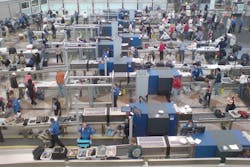Earlier this week, Paul Ciancia, 23, who stands accused of murdering Transportation Security Administration Officer Gerardo Hernandez and wounding three others in a shooting rampage at Los Angeles International Airport last month, made his first court appearance since the shooting. Ciancia, who was wounded by responding officers, did not enter a plea at the hearing. The shooting has raised questions nationwide about how to better bolster security in the unsecured areas of airport terminals.
According to Lauren Stover, assistant aviation director for public safety and security at Miami International Airport, one thing that airports can do to improve their security posture in these so-called “soft areas” is to provide training to all employees on how to spot suspicious behavior.
“Anyone working at Miami International Airport that has an airport credential gets some sort of training in behavior detection so that they are able to detect anomalies in behavior. That’s a very important methodology in being able to detect and potentially dismantle any type of threat to our airport,” Stover said. “Short of screening every single individual and every item that comes into the public area of the terminal, there isn’t any guarantee in preventing a situation like this from occurring.”
In addition, Stover said that anything an airport can do in the way of deterring a potential gunman is also very important.
“Having a visible law enforcement presence and continual training in active shooter scenarios is something we do at Miami airport and other airports do as well. Tabletop exercises, live drill training and collaboration among agencies is very critical in a situation like this,” she explained. “At MIA… our Customs and Border Protection (agents) train with the Miami-Dade Police Department in dealing with an active shooter. They train on tactical formations and also responses to a threat such as what happened at LAX, so we train for these kinds of things. Again, it is very difficult for airports to intercept an individual coming into the public area of a terminal and then opening fire with an assault weapon that’s concealed. By that time, it is very difficult to prevent loss of life.”
In testimony before the House Subcommittee on Transportation Security nearly two weeks after the shooting, TSA Administrator John Pistole said that the agency was working with airport law enforcement authorities around the country to increase the presence of uniformed officers at screening checkpoints. Pistole said that they also held a meeting at TSA headquarters with aviation industry stakeholders and law enforcement agencies to get their feedback on possible solutions that could be implemented to address these types of incidents down the road.
Although some have called for arming TSA officers, Stover said that move is not widely supported in the aviation security community.
“We believe that law enforcement is there to prevent these attacks and there needs to be sufficient staffing at airports in order to address these types of threats,” she said. “I personally don’t think (arming TSA agents) is the answer.”
Stover said that Category X airports like LAX and MIA, which are considered top terror targets due to their heavy passenger traffic volumes, they live everyday with the specter of active shooters and other types of attacks looming over their heads.
“I think this just underscores the importance of airports to continue their posture and to raise the bar on security as high as they possibly can,” said Stover. “At Miami, we not only meet, but we exceed all of the federal requirements. We’re not just about meeting the bare minimum, but doing what we can to harden our infrastructure even tighter from any potential threats.”
Stover believes that the LAX shooting will be something that all airports will be able to learn from moving forward.
“There’s always room for improvement. Not one airport out there can say that they’re 100 percent bulletproof when it comes to anything like this, so we just have to be as vigilant as possible,” added Stover. “It’s very critical that we need to know what the threat is out there against aviation, what is our vulnerability against that threat and what’s the consequence for not taking action. An active shooter situation seems to be emerging in this recent evolution of aviation security as a very viable threat as much as improvised explosive devices and other explosives. We know that the terrorists still consider aviation a top target and they’ll do whatever it takes to try and take us down but we intend to be one step ahead.”


